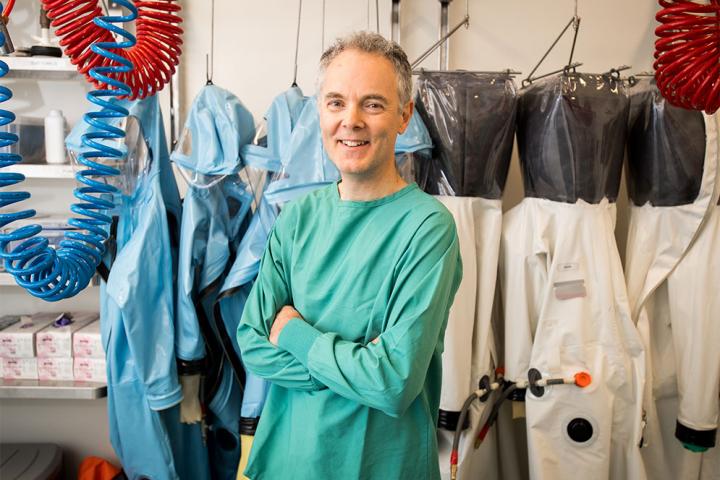Derivatives from a commonly used anti-malarial can prevent Ebola virus from entering cells

Credit: Photo by Cydney Scott, Boston University Photography.
Robert Davey, professor of microbiology at Boston University School of Medicine and researcher at Boston University’s National Emerging Infectious Diseases Laboratories (NEIDL), in collaboration with researchers at Nagasaki University, Tokushima Bunri University, Kagoshima University, and Texas Biomedical Research Institute, have discovered that certain derivatives of amodiaquine, a medication typically used to treat malaria, could provide a new therapeutic approach to treating patients infected with Ebola.
From 2014-2016, an Ebola epidemic swept through West Africa, infecting more than 28,000 people and killing more than 11,000 in Guinea, Liberia, and Sierra Leone alone. The outbreak attracted the attention of virologists from around the world, and several of them, including Robert Davey, noticed something intriguing: patients with Ebola who had been treated with amodiaquine were 31 percent less likely to die.
“People were saying ‘it’s interesting’; I wondered if it was important,” says Davey. “I thought we should test some [chemical] derivatives and see if we could find some improvement over the amodiaquine performance.”
Davey and collaborators set out to learn exactly which parts of the amodiaquine molecule were inhibiting Ebola virus infection. Their findings, published in Antiviral Research, show that modified amodiaquine derivatives are significantly less toxic and nearly 10 times more effective at blocking Ebola virus than the original amodiaquine formula that greatly reduced mortality during the West Africa outbreak.
To make the discovery, Davey teamed up with other virologists on the hunt for new antiviral therapeutics. Serendipitously, one of Davey’s colleagues from Japan–Yasuteru Sakurai, from the National Research Center for the Control and Prevention of Infectious Diseases in Nagasaki–knew another Japanese researcher, Masanori Baba of Kagoshima University, who had already made a series of amodiaquine derivatives in an effort to find new treatments for HIV and other viruses.
Davey says amodiaquine inhibits the two diseases, malaria and Ebola virus disease, in related ways. All cells need to get food from their surroundings. With malaria, amodiaquine prevents the parasite from digesting food from inside red blood cells, so it basically starves to death. Ebola virus mimics food and tricks your cells into swallowing and trying to digest it. However, the virus senses this and uses it as a trigger to begin replication, avoiding digestion. So, by interfering with normal cell digestion, amodiaquine also blocks Ebola virus infection.
“With Ebola, we are affecting your own cell’s digestive system, but for a short time, which the cell can survive,” says Davey. “And the drugs that we developed likely improve targeting to places in the cell where Ebola virus likes to get to, whereas for malaria, the drugs are best at targeting the parasite’s feeding process which it needs all the time. It’s a subtle difference in chemistry, but it’s important for making an effective drug treatment for patients.”
Working together at Davey’s former lab in San Antonio, Texas, the team–which also included Masaaki Toyama of Kagoshima University and Norikazu Sakakibara of Tokushima Bunri University–tested nearly 70 amodiaquine derivatives, mixing each one with cells infected with Ebola virus and observing the effect that each derivative had on the live virus infection.
What they found, says Davey, was encouraging. Fourteen of the compounds tested did a better job inhibiting the Zaire strain of Ebola virus disease than straight amodiaquine. They also noticed that when two particular parts of the amodiaquine molecule were modified, the potency against the virus was further increased. Then, by combining the two features, they created further potent compounds, which appeared to completely prevent the virus from entering cells.
“If you combine those two things–less toxicity and better performance against the virus–you get something called a selective index,” says Davey. “The selective index that we found easily met the criteria for clinical development.”
Davey and BU researchers Manu Anantpadma and Patrick Keiser, are taking the next steps on the long road of developing the discovery from “it’s interesting” to an approved therapy. Next, Davey says, will come testing in animal models, as well as testing the potent compounds against other strains of Ebola virus.
###
The research was supported by the National Institutes of Health.
About Boston University
Founded in 1839, Boston University is an internationally recognized institution of higher education and research. With more than 33,000 students, it is the fourth-largest independent university in the United States. BU consists of 17 schools and colleges, along with a number of multi-disciplinary centers and institutes integral to the University’s research and teaching mission. In 2012, BU joined the Association of American Universities (AAU), a consortium of 62 leading research universities in the United States and Canada.
About the National Emerging Infectious Diseases Laboratories (NEIDL)
The National Emerging Infectious Diseases Laboratories (NEIDL), part of Boston University and located on BU’s Medical Campus, is focused on research to increase the understanding of emerging infectious agents that cause human disease. In a safe and secure environment, multidisciplinary teams of microbiologists, virologists, engineers, and other scientists conduct research at Biosafety Level 2, 3 and 4 in order to identify and develop new and better treatments, vaccines and diagnostic tools for emerging diseases. It is also a center for collaboration, training, and education in emerging infectious disease research. The NEIDL is a 192,000-square-foot, 7-story building, designed and built in accordance with the most stringent specifications set by the U.S. government for conducting infectious disease research and was approved for BSL-4 research in November 2017. Part of a national network of secure facilities that study infectious diseases, the NEIDL is one of 10 BSL-4 facilities in the United States.
Media Contact
Hilary Katulak
[email protected]
617-358-1240
Related Journal Article
http://dx.
News source: https://scienmag.com/




